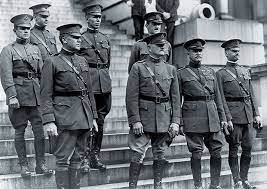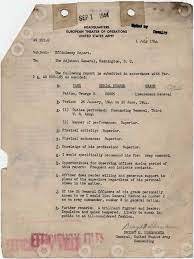“Talent is where you find it” –Tony Lucadello
Perhaps one of the best historical examples of an American military leader identifying future talent is General Fox Conner. Throughout his time as a senior leader Conner sought out and mentored individuals he identified as the next generation of strategic leaders. Indeed, Conner identified and mentored the likes of Dwight Eisenhower, George Patton, Leslie McNair and George Marshall, a virtual military murderer’s row.[i] Conner’s influence ensured the long-term success of the U.S. Army following its achievements in the First World War. While Conner could not predict when the next war would occur, he could predict who should be in positions of strategic leadership.
Leaders throughout the joint force serve as scouts for their respective service. From the moment an individual pins on the stripes of a non-commissioned officer or the gold bars of a second lieutenant, they continually observe and evaluate subordinates on performance and potential to advance in rank and position. Despite the enormous responsibility placed on young men and women, there is a dearth of training and education on what it takes to properly observe and evaluate talent.
This review will examine two books on the topic of scouting, the ideas within the books, and their implications for the joint force.
Perhaps the premier book on scouting is Gare Joyce’s Future Greats and Heart Breaks: A Year Undercover in the Secret World of the NHL Scouts. In this book the author spends a year shadowing the professional scouts of the NHL’s Columbus Blue Jackets. Similar to Joyce’s observations on scouting is Mark Winegardner’s Prophet of the Sandlots: Journeys with a Major League Scout. Winegardner who is known for The Godfather Returns and The Godfather’s Revenge spends a year following Tony Lucadello, a baseball scout for the Philadelphia Phillies who became a legend for finding and signing hall of famer Mike Schmidt.
The insights Winegardner culls from Lucadello, and Joyce’s observations while scouting translate easily into the realm of the military. For example, both authors highlight how the successes and failures of Major League Baseball and the National Hockey League depend on scouts identifying talent. As Joyce states, “the league is only as good as the scouts, if there are bad coaches or bad general managers, there are bad teams. If the scouts are bad, you’ll end up with a bad league and a bad game.”[ii] If leaders throughout the military consistently inflate evaluations or fail to properly rate the best performers then there is significant risk of a bad military.
Each book conveys unique insights into the world of scouting. Some of the similar categories each author highlights include the time and detail dedicated to each individual prospect, understanding the difference between performance and potential, and risk management.
Looking at “What’s Inside”
Written evaluations are the military’s scouting reports, but evaluations are a snapshot in time and not always indicative of long term potential. In Winegardner’s discussions with Lucadello, the author pulls out the gem that a scout must see what’s inside of a player, not just physical and performance metrics.[iii] Often these observations come from taking the time to talk to the player, the player’s family, and the player’s friend. In a similar way, Joyce writes in his book on the failure of NHL scouts to observe or talk to athletes outside of the rink or outside formal interview sessions.[iv] Seeing what’s inside of a subordinate leader is an investment of time and effort. Senior leaders who write evaluations require time those they rate (or senior rate) to fully appreciate their potential to lead at higher levels.
While shadowing the scouts for the Columbus Blue Jackets, Gare Joyce writes of the time he spend observing interviews between the professional NHL scouts and prospective draft picks. Joyce observes that scouts had limited time to talk to dozens of players and thus the interviews barely scratched the surface of each player’s true personality. Joyce was able to follow up the formal interviews with informal discussions over meals, or while playing ping-pong at a hotel. What Joyce tells us is that the informal atmosphere and unguarded dialog revealed more about a player’s character than what is generally seen as theater of formal sit-down interviews.[v] Leaders writing evaluations for other to make judgements on a person’s worth to an organization must have a semblance of a relationship with their subordinates. Leaders should know who they lead.
These snapshots in time that decision makers get for athletes is mirrored in military selection boards. The decision to recommend someone for command of 5,000 soldiers, or command of a destroyer, submarine, or air wing is an enormous responsibility of board members who have little to zero firsthand knowledge of the people they are evaluating. The words and stratification on each evaluation report are all the board will see. With little awareness into the character of each officer, the job of the military leader as the scout for the selection boards gains more significance.
Risk
The art of selecting athletes in a draft or military leaders for assignments, promotion and command is a form of risk management. In both circumstances organizations are investing limited time and money to develop and compensate each individual for their effort and future performance. While there is no such thing as perfect knowledge or perfect information when it comes to predicting future performance, selecting people who will have enormous responsibility for other people’s lives or economic success requires substantial investment.
Professional sports teams assume enormous financial risk with every rookie selected in a draft. The nation takes risk in appointing men and women into positions of power where their decisions will impact the lives of those they lead. While Joyce observed the risk of limited interaction with prospects, Winegardner witnessed the power of a scout who took time to observe, understand and know the players who he recommended as likely to succeed in the big leagues. Indeed, the author writes how Lucadello would gain and maintain contact with a prospect over multiple seasons, often taking the time to know their family, their friends, and the baggage each player carried with them onto the baseball diamond. By mitigating risk in selection, we mitigate the results on the diamond, on the rink, and on the battlefield.
The best scouts don’t sit in the stands, they sit in the locker room. Joyce observes in his book that often the best scouts talk to a player’s peers, as there is nothing to observe that other players don’t already know.[vi] Recently, the Army adopted the Battalion Commander Assessment Program (BCAP) and the Colonel’s Command Assessment Program (CCAP) to better evaluate and better select and assign battalion and brigade commanders. According to the Army, these programs are already having a successful impact, and are certainly a welcome improvement over the rapid look at previous evaluations to determine who will command at senior levels. These assessments include formal interviews, but also consider 270 degree feedback (from peers and superiors from previous assignments), physical fitness evaluations, and general informal observations. According to the Army, these programs fill the gap providing current strategic leaders with better ways of predicting the next set of strategic leaders.
More than understanding the risk in selecting personnel, both authors discuss how major league scouts are held accountable should they consistently fail to find talent. Scouts are often on short-term contracts and must continually prove their worth to their organization. Failures to find talent, or continual signing of athletes who don’t fulfill potential often results in a non-renewal of the scout’s contract. This is a marked departure from the military which does little to hold to account those who elevate toxic leaders. While leaders are often held to account for administrative issues such as submitting late evaluations, heaping praise and recommending someone for promotion who later fails tactically, strategically, or ethically has no impact to one’s career.
Performance and Potential
A poignant observation from Lucadello is that every player he observes, no matter how talented, is a long-shot to make into the major leagues.[vii] Most of the high school and college stars never get signed. Indeed, every new recruit that raises his or her right hand at an initial enlistment or commissioning is a long-shot to eventually serve at the highest ranks and echelons of the joint force. Translating this into military practice, leaders should seek to raise those they evaluate not in anticipation of serving as the next Chairman or Sergeant Major of the Army, but rather with the understanding of finding high performers who will serve 20-30 years in relative senior positions.
What baseball, hockey, and football scouts have in common is the necessity to understand the difference between performance and potential. Scouts who spend countless hours observing athletes must have an understanding of the competition each athlete faces when evaluating performance against potential. High school seniors hitting homeruns against freshman pitchers says little on their ability to hit a major league curveball. A 20-year old hockey player skating around a 16-year old third line defenseman.[viii] Observing stronger players against weak competition can skew evaluations and selection for promotion.
Assignments of officers and NCOs can lead to disproportionate evaluations of talent. Average officers and NCOs serving with a multitude of below average leaders of the same rank can lead to a high stratification (#1 of 50) while above average leaders serving in selective units can suffer in their respective stratification. Board members who get a 1-2 minute glimpse at a packet don’t have the context of the evaluated leader’s competition. And just as success in minor league baseball or minor league hockey doesn’t always translate to success in the big leagues, tactical acumen doesn’t always translate to strategic thought. As the scouts of the joint force, officers responsible for writing evaluations must understand this context and communicate in the written evaluation.
A Military Scouting Report
Conclusion
Large complex organizations, from professional sports teams to military organizations rely on a multitude of factors for long term success. In writing about the New England Patriots Dynasty, Jeff Benedict observed that winning is more than tactics and Xs and Os. Winning relies upon personnel decisions, player development, support staff, and scouts.[ix]
Every leader who writes an evaluation is a scout for the joint force. Understanding what professional scouts look for in identifying potential talent can improve how these leaders understand, rate and stratify the talent that surrounds them. As such, Prophet of the Sandlots and Future Greats and Heart Breaks not only work as entertaining reading, but as a source of insights and enhanced professional knowledge that can lead to a level of self-reflection. They are a welcome addition to any leader’s bookshelf.
[i] Edward Cox, Grey Eminence: Fox Conner and the Art of Mentorship. (New Forums Press. Stillwater, OK, 2011). Kindle, loc 154.
[ii] Gare Joyce, Futre Greats and Heartbreaks: A Year Undercover in the Secret World of NHL Scouts. (Doubleday Press, Canada 2007), 6.
[iii] Mike Winegardner, , Prophet of the Sandlots: Journeys With a Major League Scout. (Prentice Hall Press. New York, NY, 1990).47.
[iv] Joyce, 87.
[v] Joyce, 120-121.
[vi] Joyce, 168.
[vii] Winegardner, 57
[viii] Joyce, 220-224.
[ix] Jeff Benedict, The Dynasty (Avid Reader Press, New York, NY, 2020), 87.




